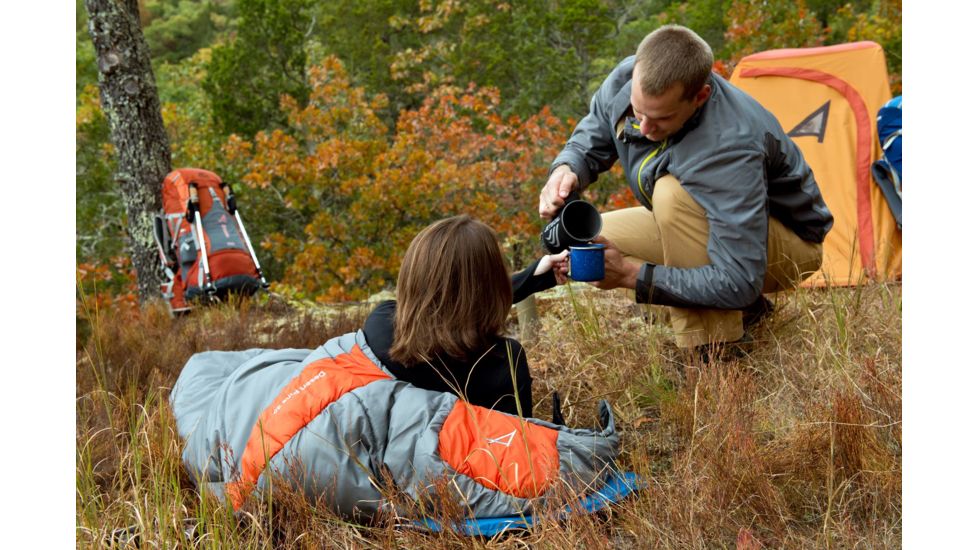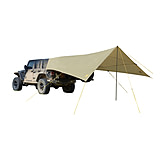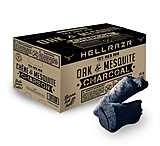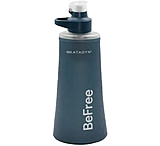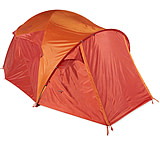Every year, millions of people, including myself, venture out into the wilderness to get in touch with nature. Whether car camping, canoeing, long-distance biking, or backpacking, you want to sleep comfortably after a long day. A sleeping bag is crucial camping gear that will allow you to get a good night's rest. It is a guarantee that you will spend at least one-third of your time in the wilderness in a sleeping bag, which is an apparent reason to invest time into picking one.![]()
Sleeping bags come in all shapes and sizes, from mummy bags that fit you snuggly to 2-person sleeping bags. No matter your body type, there is a sleeping bag to suit you. Sleeping bag choices are divided into temperature, shape, and materials.
What Temperature Rating Sleeping Bag Should I Get?
The first question you need to ask yourself is where you plan on using the sleeping bag. All sleeping bags utilize an "EN" temperature comfort rating. This temperature rating is also determined in static conditions using a sleeping pad underneath the sleeping bag. As a general rule of thumb, women sleep warmer throughout the night, so their temperature rating will be slightly lower than the stated comfort rating. Another thing to consider is that although your bag may be rated at a specific temperature, you can always layer up before getting in it to bump up that rating.
If you are primarily camping in the summer months that will not go below 35 degrees at night, then a one-season (summer bag) sleeping bag will perform fine.
If you are camping or using a sleeping bag from early spring into late autumn, a bag rated to +10 to +35 degrees will work, depending on your climate. These are called three-season sleeping bags.
Lastly, a dedicated cold-weather sleeping bag is for you if you think you will be sleeping in conditions colder than +10 degrees.
What Shape of Sleeping Bag Is Best?
Sleeping bags come in an assortment of sizes and shapes. Some of the most popular styles of bags are mummy bags and rectangular bags. They both have their advantages and disadvantages.
Mummy Sleeping Bags
Mummy bags get their name from how they hug your body closely and have a hood for your head. Because these bags have a hood and hug your body closely, they will keep in more of your body's radiant heat, which will keep you warm throughout the night. One of the disadvantages of a Mummy sleeping bag is that there is not much room to move around while you're sleeping.
Rectangular Sleeping Bags
Rectangular bags are more of the traditional style bag we all grew up with as a kid. They lack the hood and are far looser fitting than the mummy bag. These bags are usually the "go-to" bag for summer camping because they allow a greater range of movement and are not as hot as mummy bags.
The disadvantage to this style is that roughly 33% of your body's heat is lost through your head during colder temperatures. Since this bag has no hood and doesn't hug your body tightly, you will lose more body heat.
What Insulation Is Best for Sleeping Bags?
Generally, sleeping bags are made of either synthetic insulation or goose down. Both these insulators have their advantages and disadvantages.
Synthetic Insulation
Synthetic insulation has two significant advantages over down. First, synthetically insulated sleeping bags are much cheaper than ones made of down. Synthetic insulation also does a great job of keeping you warm after it is wet.
The significant disadvantages of synthetic are its weight and size. Synthetic sleeping bags usually are considerably larger and heavier than down bags that are rated at the same comfort rating.
Goose Down Insulation
Goose Down insulation in sleeping bags allows the bag to be compressed extremely small, even as small as a coffee can for some down bags. Not only do they take up little space when compressed, but they also weigh much less compared to synthetic sleeping bags.
The major flaw of down insulation is that it loses most of its insulating properties when wet. This can be a problem for backpackers that have to cross various water features.
How Much Should a Sleeping Bag Weigh?
Weight is a non-issue if you travel up to two miles to your campsite. If you plan on traveling on foot or bike for many miles to your camp, then sleeping bag weight is one of the most important factors. Sleeping bags generally weigh two to six pounds, most in the middle. If you want a sleeping bag with pockets and extra heat baffles, plan on your bag being heavier.
It all comes down to how committed you are to camping or backpacking. If your plans include spending every weekend in the wilderness, you should pick a bag right for what you need, regardless of price.
Why Aren't You Supposed to Roll a Sleeping Bag?
When you make it to your campsite and set up your tent, the next thing you will want to do is lay your sleeping bag out inside the tent. This will allow the bag to regain its loft, which keeps you warm. You should also store your bag unraveled; never leave it compressed for weeks.
Ounces equal pounds, and pounds equal pain. Cut weight whenever and wherever you can.
Don't get down wet! If you don't protect that nice goose-down sleeping bag from water, you'll sleep in what feels like a damp garbage bag all night. You will probably be cold the whole night in wet sleeping bags. If your sleeping bag does get wet, squeeze (but don't ring) as much moisture out as possible. Next, hang up your bag and let it drip dry further, keeping the dry parts from getting wet.
Sleeping bags do not defy the facts of life; you get what you pay for. Don't expect a high-quality down bag with a comfort rating of 10 degrees for $50. If you're on a budget, then check out our selection of the best backpacking sleeping bags under $100.
You'll spend 1/3 of your time sleeping in it, so take advantage of this camping essential.
Buy Sleeping Bags Online at OpticsPlanet!
Whether you need a backpacking sleeping bag for adults or a kid's sleeping bag, OpticsPlanet has the perfect bag for you and your budget. Make sure to check out our sleeping bag accessories like sleeping bag liners and other add-ons to enhance your comfort and protect your bag from the elements. Looking for the perfect sleeping bad for your camping setup? Then check out our Sleeping Pad Buyer's Guide to learn more about buying the best camping accessories for your next adventure.



